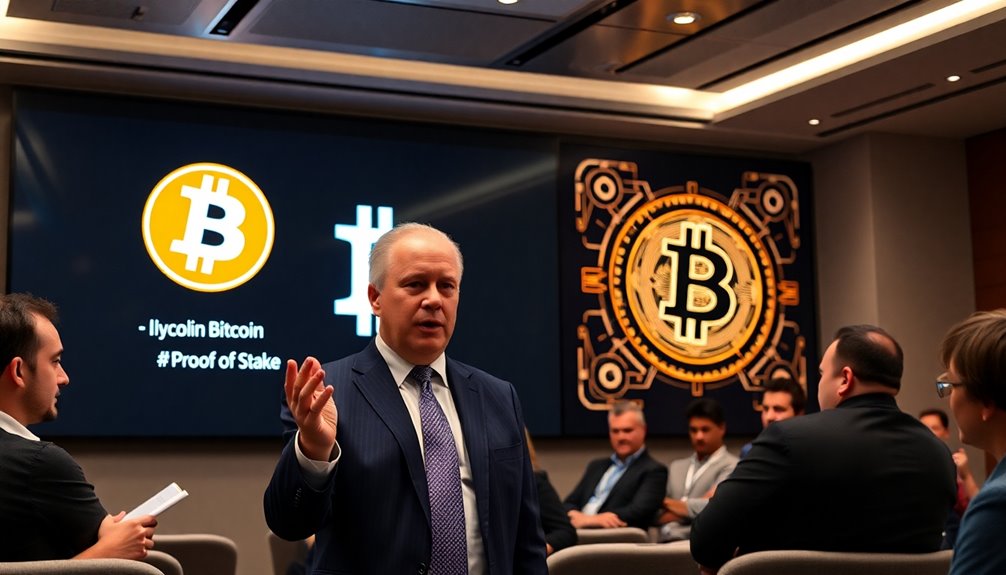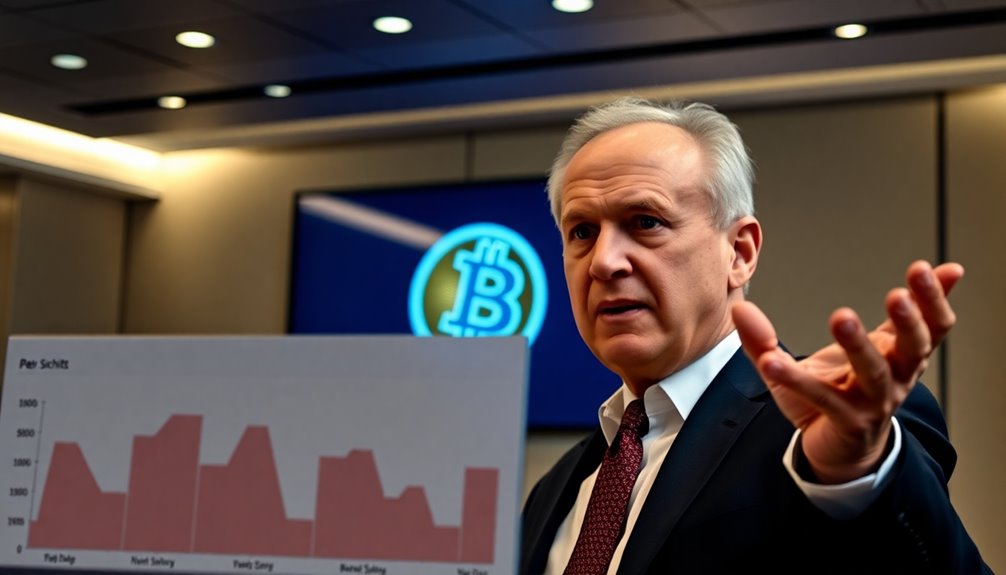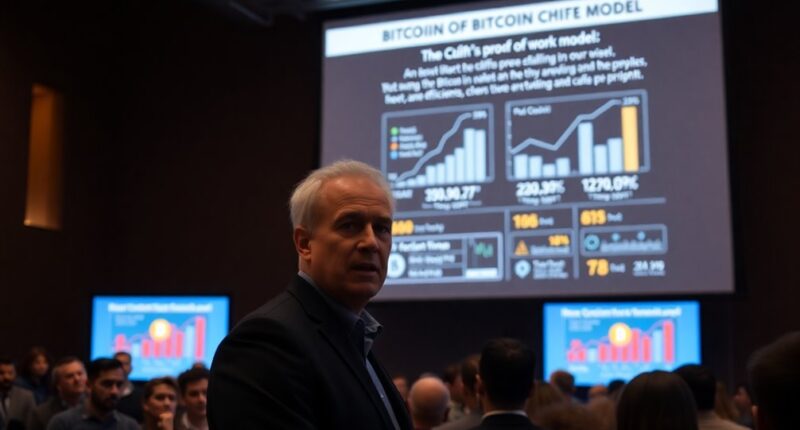Peter Schiff critiques Bitcoin's Proof of Work model, calling it inefficient because of its massive energy consumption and negative environmental impact. Each transaction consumes significantly more energy than traditional systems like Visa. Mining operations also contribute to substantial CO2 emissions and create extensive electronic waste. This inefficiency, combined with Bitcoin's volatile nature and speculative market status, raises questions about its long-term viability as a stable asset. To uncover more about this issue, keep exploring the topic.
Energy Consumption Concerns

Energy consumption is a major concern when it comes to Bitcoin's Proof of Work model. You might be surprised to learn that Bitcoin's annual energy usage ranges between 91 to 160 terawatt-hours, comparable to entire countries like Finland or Argentina. Each Bitcoin transaction can consume up to 1,200 kWh, which is over 500,000 times more electricity than a Visa transaction. With more than 300,000 transactions daily, the cumulative energy demand is staggering. Additionally, Bitcoin mining generates approximately 22-23 million metric tons of CO2 annually, raising serious environmental concerns. Although over 50% of Bitcoin mining now utilizes renewable energy sources, the high energy consumption and carbon emissions still present significant challenges for its long-term sustainability. Furthermore, Bitcoin's energy requirements for mining are expected to continue increasing as the complexity of calculations grows with each mined block.
Inefficiency of the Proof of Work Process

While Bitcoin's Proof of Work (PoW) model secures the network, it suffers from significant inefficiencies that hinder its overall effectiveness.
You'll notice that Bitcoin processes only 5-7 transactions per second, lagging far behind systems like Visa. New blocks take about 10 minutes to generate, limiting transaction speed and scalability.
This resource-intensive process requires powerful computers, consolidating mining among a few large players. Additionally, the complex problems miners solve are computationally wasteful, consuming vast amounts of energy and driving up costs. PoW networks like Bitcoin consume over 99% more energy than PoS networks, as you can see, the need for specialized equipment leads to high operational expenses and opportunity costs, diverting resources from potentially more productive uses.
These inefficiencies raise concerns about Bitcoin's practicality in widespread applications.
The Lack of Tangible Value

Bitcoin's inefficiencies in transaction processing lead to further scrutiny of its overall value proposition, particularly regarding its tangible worth.
Unlike traditional assets like gold, which possess intrinsic value due to their physical properties, Bitcoin exists solely in a digital realm. Critics argue that its market valuation, while substantial, lacks the backing of tangible assets.
Instead, Bitcoin's worth relies heavily on collective belief and perceived scarcity, much like fiat currencies. This speculative nature raises questions about its stability and long-term value. While supporters point to its digital attributes and network effects, many still view Bitcoin primarily as a speculative investment rather than a reliable store of value, emphasizing its lack of intrinsic worth. Utility as a decentralized monetary system allows for peer-to-peer transactions that enhance its value proposition.
Environmental Impact of Bitcoin Mining

As concerns about climate change grow, the environmental impact of Bitcoin mining has come under intense scrutiny.
You might be surprised to learn that Bitcoin mining consumes around 25 Terawatt hours annually, rivaling Morocco's energy use. This process emits roughly 86 megatons of carbon, primarily due to fossil fuel reliance, with only a fraction of energy sourced from renewables. Additionally, Bitcoin mining generates considerable electronic waste, comparable to that of the Netherlands, and has significant water and land footprints, especially in countries like Norway and Sweden. In fact, Bitcoin mining affects 1,870 square kilometers of land globally, highlighting its extensive environmental footprint.
As the greenhouse gas emissions could hinder climate goals, it's clear that sustainable practices and regulatory measures are urgently needed to address these pressing environmental issues.
Economic Inefficiency and Speculation

Despite its innovative technology, the economic inefficiency of Bitcoin's Proof of Work model raises significant concerns. The massive energy consumption required to solve complex puzzles leads to high operational costs. As mining puzzles grow more challenging, miners need increasingly powerful, energy-intensive hardware, worsening this inefficiency. Even though PoW ensures network security, preventing double-spending, it also creates economic incentives that align miners' interests with the network's health. However, many are exploring alternative consensus models, like Proof of Stake, which offer more energy-efficient solutions. Additionally, Bitcoin's speculative nature complicates its viability as a stable currency, often relegating it to the status of a risky investment rather than a reliable medium of exchange. This is further complicated by the fact that higher investor emphasis on network security correlates with Bitcoin's price, creating a complex feedback loop that may undermine its efficiency.
The Volatility of Bitcoin Prices

While many see Bitcoin as a revolutionary asset, its notorious price volatility presents both opportunities and challenges for investors. You might notice that Bitcoin's volatility can exceed 100%, like it did in November 2022, leading to significant price swings. However, this volatility has gradually declined over time, with lower peaks in recent years. Compared to traditional assets like gold, Bitcoin is still more volatile, but it can be less volatile than some stocks during market crises. Despite these fluctuations, Bitcoin's returns often remain disproportionately positive, reflecting sustained investor interest. Ultimately, understanding this volatility is crucial for navigating Bitcoin's unpredictable landscape and making informed investment decisions. Peter Schiff's skepticism highlights the potential for significant downturns amid this volatility.
Technological Alternatives to Proof of Work

With growing concerns over energy consumption and environmental impact, many developers are exploring technological alternatives to Bitcoin's Proof of Work model.
One popular option is Proof-of-Stake (PoS), which cuts energy use by relying on validators who stake their coins instead of solving complex puzzles. PoS significantly reduces energy consumption compared to PoW.
Another approach, Delegated Proof-of-Stake (DPoS), introduces a voting system for block producers, boosting efficiency but potentially increasing centralization.
You might also encounter Proof-of-Activity (PoA), which combines Proof-of-Work and Proof-of-Stake for enhanced security and efficiency.
Other alternatives like Proof-of-Capacity and Proof-of-Elapsed Time focus on reducing energy consumption through different resource allocations.
These innovations aim to create more sustainable blockchain ecosystems while maintaining security and scalability.
Future Prospects for Bitcoin and Its Viability

As the cryptocurrency landscape evolves, Bitcoin's future prospects hinge on several critical factors, including institutional adoption, market dynamics, and its role as a store of value. Analysts predict Bitcoin could soar to nearly $200,000 by 2025, driven by strong institutional interest in spot ETFs. Fidelity's long-term view suggests it might reach $1 billion by 2040, thanks to Metcalfe's Law. While Bitcoin's finite supply bolsters its appeal, volatility poses challenges for widespread use as a medium of exchange. Additionally, macroeconomic influences and regulatory hurdles will shape its journey. However, as services like Strike enhance usability, Bitcoin's potential as a global store of value continues to strengthen, attracting both retail and institutional investors alike. Current economic conditions mirror those that led to the removal of the gold standard in 1971, emphasizing the relevance of Bitcoin in today's financial landscape. This relevance is further highlighted by the increasing interest in Gold IRAs as a hedge against currency devaluation.
Conclusion
In conclusion, Peter Schiff raises valid concerns about Bitcoin's proof of work model, highlighting its inefficiency and environmental impact. The lack of tangible value and the volatility of Bitcoin prices add to the skepticism surrounding its long-term viability. While technological alternatives may emerge, the current system faces significant challenges. As you consider investing or utilizing Bitcoin, it's crucial to weigh these factors and stay informed about the evolving landscape of cryptocurrency.









